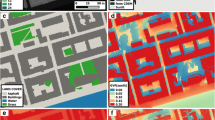Abstract
Results from measurements of long-wave radiative flux divergence on calm, cloudless nights from within an urban canyon are presented. Results show the existence of three-dimensional (volume) radiative divergence in the canyon-air system. The results are compared with air temperature cooling rates (energy storage change) in the canyon. With calm, cloudless conditions, radiative divergence is the dominant mechanism controlling air temperature changes. In the early part of the night this results in air cooling, but radiative warming was commonly observed after midnight. Canyon-air volume radiative divergence is found to be considerably less than that observed previously above roof-level, and in rural areas. Measured cooling rates in the canyon are poorly predicted by a surface-oriented cooling approach. This again points to the importance of the atmospheric radiation balance.
Similar content being viewed by others
References
Brooks, D. L.: 1950, A tabular method for the computation of temperature change by infrared radiation in the free atmosphere, J. Meteorol. 7, 313–321.
Brunt, D.: 1941, Physical and Dynamical Meteorology, Cambridge Univ. Press, London, 428 pp.
Corradini, C. and Severini, M.: 1975, Laboratory experimental check of radiative air cooling theory, Quart. J. Roy. Meteorol. Soc. 101, 163–167.
Elsasser, W. M. and Culbertson, M. T.: 1961, Atmospheric radiation tables, Meteorol. Monog. 4, No. 23, Amer. Meteorol. Soc., Boston.
Fleagle, R. G.: 1953, A theory of fog formation, J. Marine Res., 12, 43–50.
Fuggle, R. F. and Oke, T. R.: 1976, ‘Long-wave radiative flux divergence and nocturnal cooling of the urban atmosphere. I: Above roof-level’, this issue, p. 113.
Funk, J. P.: 1960,Measured radiative flux divergence near the ground, Quart. J. Roy. Meteorol. Soc. 86, 382–389.
Gaevskaya, G. N., Kondratyev, K. Ya., and Yakushevskaya, K. Ye.: 1963, Radiative heat flux divergence and heat regime in the lowest layers of the atmosphere, Archiv Meteorol. Geophys. Bioklima., Ser. B, 12, 95–108.
Hage, K. D.: 1972, Nocturnal temperatures in Edmonton, Alberta, J. Appl. Meteorol., 11, 123–129.
Hage, K. D.: 1975, Urban-rural humidity differences, J. Appl. Meteorol. 14, 1277–1283.
I.H.V.E.: 1965, I.H.V.E. Guide to Current Practice, Instil. Heat, and Ventil. Engin., London.
Kondo, T.: 1971, Effect of radiative heat transfer on profiles of wind, temperature and water vapour in the atmospheric boundary layer, J. Meteorol. Soc. Japan, 49, 75–94.
Kondratyev, K. Ya.: 1965, Radiative Heat Exchange in the Atmosphere, 1st Engl. Ed., Pergamon, New York, 411 pp.
Kondratyev, K. Ya.: 1972, Radiation Processes in the Atmosphere, Second I.M.O. Lecture, WMO-No. 309, World Meteorol. Org., Geneva, 214 pp.
Kraus, H.: 1958, Untersuchungen über den nächtlichen Energietransport und Energiehaushalt in der Bodennahen Luftschicht bei der Bildung von Strahlungsnebeln, Berichte des Deutsch. Wetterdienstes, 7, No. 48.
Lee, T. H. and Gille, J. C.: 1972, ‘Temperature propagation in a non-grey radiating fluid’, Proc. Conf. Atmos. Rad., Fort Collins, Colorado, Aug. 7–9, 1972, Amer. Meteorol. Soc., 271–275.
Lieske, B. J. and Stroschein, L. A.: 1967, Measurements of radiative flux divergence in the Arctic, Archiv Meteorol. Geophys. Bioklima., Ser. B, 15, 68–81.
List, R. J.: 1966, Smithsonian Meteorological Tables, 6th ed., Smithsonian Misc. Collect., Vol. 114, Smithsonian Instit., Washington, D.C., 527 pp.
Nunez, M. and Oke, T. R.: 1976, The energy balance of an urban canyon, submitted to J. Appl. Meteorol.
Okamoto, M.: 1971, Radiative and turbulent heat transfer under extremely stable conditions near the ground, Geophys. Mag. (Japan Meteorol. Agency), 35, 293–330.
Okamoto, M. and Funk, J. P.: 1971, The divergence of eddy heat flux and the temperature fluctuations in stable conditions, Geophys. Mag. (Japan Meteorol. Agency), 35, 137–150.
Oke, T. R. and East, C.: 1971, The urban boundary layer in Montreal, Boundary-Layer Meteorol. 1, 411–437.
Oke, T. R. and Maxwell, G. B.: 1975, Urban heat island dynamics in Montréal and Vancouver, Atmos. Environ. 9, 191–200.
Pasquill, F.: 1950, Some further considerations of the measurement and indirect evaluation of natural evaporation, Quart. J. Roy. Meteorol. Soc. 76, 287–301.
Timanovskaya, R. G. and Farapanova, G. P.: 1967, Determination of the flux divergence in the atmospheric surface layer, Bull. U.S.S.R. Acad. Sci., Ser. Phys. Atmos. Ocean., 3, 742–748.
Yamamoto, G.: 1952, On a radiation chart, Sci. Rep. Tohoku Univ., Ser. 5, 4, 9–23.
Zdunkowski, W. and Trask, D. C.: 1971, Application of a radiative-conductive model to the simulation of nocturnal temperature changes over different soil types, J. Appl. Meteorol. 10, 937–948.
Zdunkowski, W., Henderson, D., and Hales, J. V.: 1967, Prediction of nocturnal temperature changes during a calm night, Beit. Phys. Atmos. 40, 144–157.
Author information
Authors and Affiliations
Rights and permissions
About this article
Cite this article
Nunez, M., Oke, T.R. Long-wave radiative flux divergence and nocturnal cooling of the urban atmosphere. Boundary-Layer Meteorol 10, 121–135 (1976). https://doi.org/10.1007/BF00229280
Received:
Issue Date:
DOI: https://doi.org/10.1007/BF00229280




